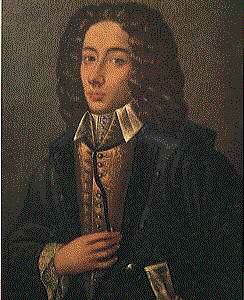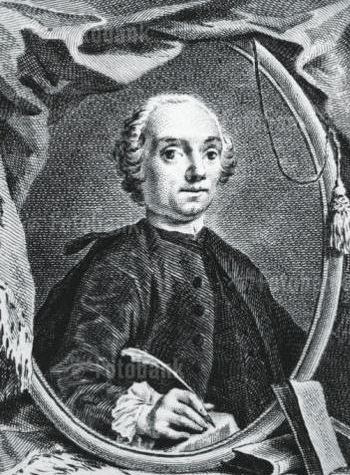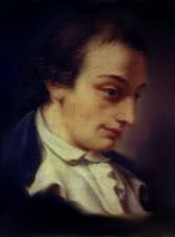<Back to Index>
- Composer and Violinist Giovanni Battista Pergolesi, 1710
- Playwright and Librettist Pietro Chiari, 1712
- Composer Pietro Alessandro Guglielmi, 1728
PAGE SPONSOR

Giovanni Battista Pergolesi (4 January 1710 – 16 March 1736) was an Italian composer, violinist and organist.
Born at Iesi, Pergolesi studied music there under a local musician, Francesco Santini, before going to Naples in 1725, where he studied under Gaetano Greco and Francesco Feo among others. He spent most of his brief life working for aristocratic patrons like the Colonna principe di Stigliano, and duca Marzio IV Maddaloni Carafa.
Pergolesi was one of the most important early composers of opera buffa (comic opera). His opera seria, Il prigionier superbo, contained the two act buffa intermezzo, La Serva Padrona (The Servant Mistress, 28 August 1733), which became a very popular work in its own right. When it was performed in Paris in 1752, it prompted the so-called Querelle des Bouffons ("quarrel of the comic actors") between supporters of serious French opera by the likes of Jean - Baptiste Lully and Jean - Philippe Rameau and supporters of new Italian comic opera. Pergolesi was held up as a model of the Italian style during this quarrel, which divided Paris's musical community for two years.
Among Pergolesi's other operatic works are his first opera La conversione e morte di San Guglielmo (1731), Lo frate 'nnamorato (The monk in love, 1732, to a text in Neapolitan language), L'Olimpiade (31 January 1735) and Il Flaminio (1735). All his operas were premiered in Naples, apart from L'Olimpiade, which was first given in Rome.
Pergolesi also wrote sacred music, including a Mass in F and his Magnificat in C major. It is his Stabat Mater (1736), however, for male soprano, male alto, string orchestra and basso continuo, which is his best known sacred work. It was commissioned by the Confraternità dei Cavalieri di San Luigi di Palazzo. It has erroneously been said that it was commissioned by an order of monks. Rather, a group of pious and charitable gentlemen, such as existed in cities all over Italy, commissioned the work. It was this group that presented an annual Good Friday meditation in honor of the Virgin Mary; Pergolesi's work replaced one composed for the same forces by Alessandro Scarlatti only nine years before, but which was already perceived as "old - fashioned," so rapidly had public tastes changed.
Whilst classical in scope, the opening section of the setting demonstrates Pergolesi's mastery of the Italian baroque 'durezze e ligature' style, characterized by numerous suspensions over a faster, conjunct bassline. The work remained popular, becoming the most frequently printed work of the 18th century, and being arranged by a number of other composers, including Johann Sebastian Bach, who used it as the basis for his cantata Tilge, Höchster, meine Sünden (Root out my sins, Highest One), BWV 1083.
Pergolesi wrote a number of secular instrumental works, including a violin sonata and a violin concerto. A considerable number of instrumental and sacred works once attributed to Pergolesi have since been shown to be misattributed. Much of Igor Stravinsky's ballet Pulcinella, which ostensibly reworks pieces by Pergolesi, is actually based on spurious works. The Concerti Armonici are now known to have been composed by Unico Wilhelm van Wassenaer. Many colorful anecdotes related by his early biographer, Florimo, were later revealed as fabrication, though they furnished material for two nineteenth century operas broadly based on Pergolesi's career.
Pergolesi died at the age of twenty - six in Pozzuoli from tuberculosis.

Abbot Pietro Chiari (25 December 1712, Brescia - 31 August 1785, Brescia) was an Italian playwright, novelist and librettist.
He was a Jesuit until leaving the order in 1747. From 1747 to 1762 he was court poet of Duke Francis III of Modena, in Venice, although not at the public cost. During this period he wrote nearly 60 comedies, which from 1761 or earlier often brought him into conflict with his rival Goldoni. With a deep hatred for the style of Molière, Chiari made comédie larmoyante fashionable in Italy under the name commedia fiebile. He also edited the Gazzetta Veneta from 1761 to 1762, when he returned to his birthplace to spend his final years.

Pietro Alessandro Guglielmi (December 9, 1728 – November 19, 1804) was an Italian opera composer.
Guglielmi was born in Massa. He received his first musical education from his father, and afterwards studied under Francesco Durante at the Conservatorio di Santa Maria di Loreto at Naples. His first operatic work, produced at Turin in 1755, established his reputation, and soon his fame spread beyond the limits of his own country, so that in 1762 he was called to Dresden to conduct the opera there. He remained for some years in Germany, where his works met with much success, but the greatest triumphs were reserved for him in England.
He went to London, according to Charles Burney, in 1768, but according to Florimo in 1772, returned to Naples in 1777. He continued to produce operas at an astounding rate, but was unable to compete successfully with the younger masters of the day. In 1793 he became maestro di cappella at St Peter's, Rome, where he died in 1804.
He was a very prolific composer of Italian dramma giocoso and commedia per musica operas, and there is in most of his scores a vein of humor and natural gaiety not surpassed by Domenico Cimarosa himself. In opera seria he was less successful. But here also he shows at least the qualities of a competent musician. Considering the enormous number of his works, his unequal workmanship and the frequent instances of mechanical and slipshod writing in his music need not surprise us.
He also wrote oratorios and miscellaneous pieces of orchestral and chamber music. Of his eight sons two at least acquired fame as musicians: Pietro Carlo Guglielmi (1763 - 1827), a successful imitator of his father's operatic style, and Giacomo Guglielmi, an excellent singer.